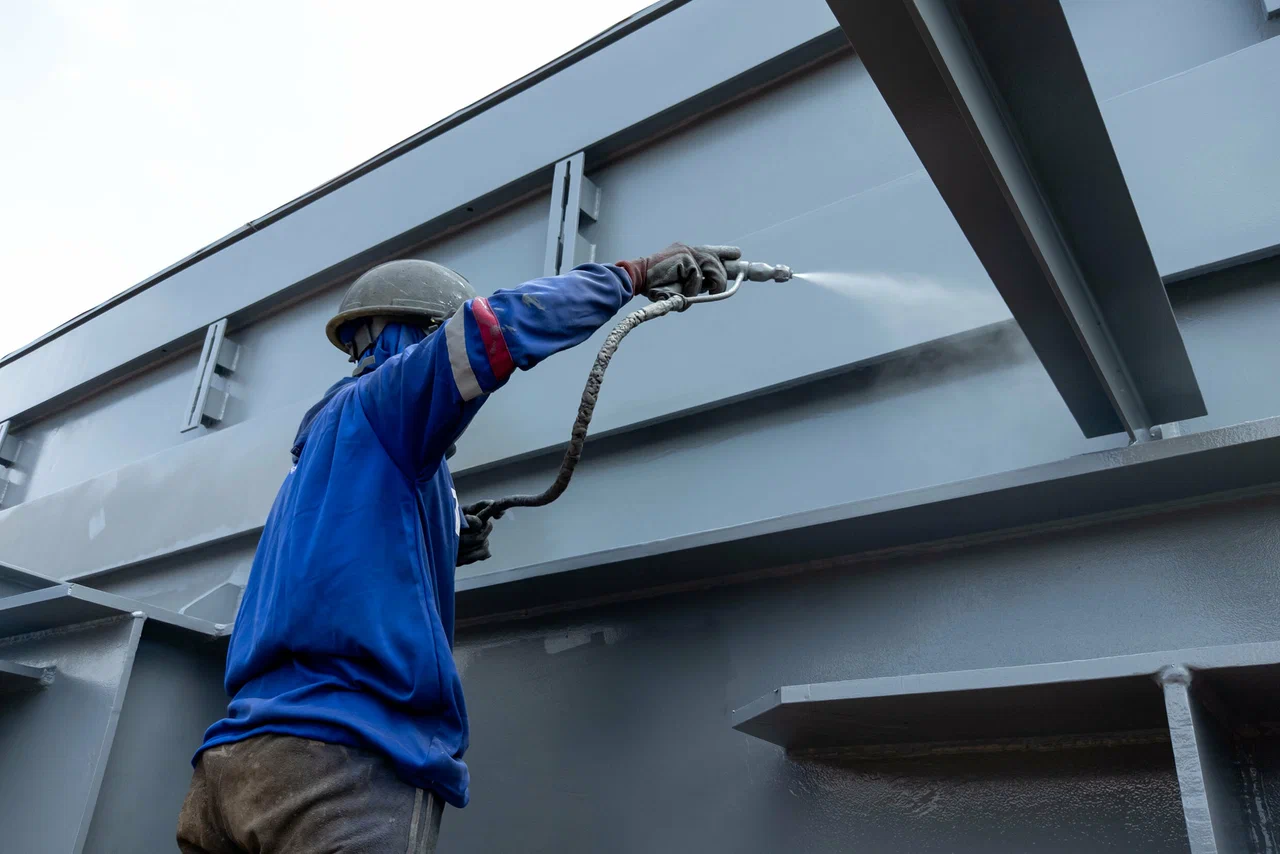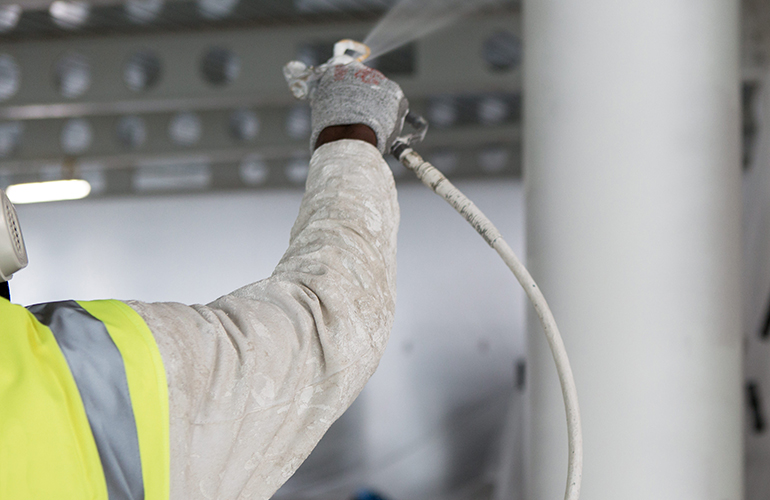Intumescent paint plays a critical role in passive fire protection systems across residential, commercial, and industrial buildings. Unlike standard coatings, this type of fire-retardant material expands under high heat, creating a protective char layer that insulates structural components against fire. Understanding how intumescent coatings work and where they offer the most protection can help building owners, spray foam insulation contractor, and facility managers make more informed decisions.
This guide outlines how intumescent paint enhances fire resistance, how it’s applied, where it’s most effective, and how it compares to other fire protection methods.
How Intumescent Paint Works During a Fire Event
Intumescent coatings are engineered to react to heat by expanding and forming a thick, insulating barrier. This barrier slows down the rate at which heat is transferred to structural elements like steel and wood.
Chemical Reaction Behind Expansion
- Intumescent paints contain binders, acids, and carbon sources.
- When exposed to temperatures around 392°F (200°C) or higher, the coating expands up to 50 times its original thickness.
- This expansion forms a foam-like char that acts as a thermal barrier.
Thermal Delay Benefits
- Keeps structural elements below failure temperature longer.
- Allows more time for building evacuation and emergency response.
- Reduces the spread of fire between structural compartments.
Where Intumescent Paint Is Most Effective
- Exposed steel columns and beams
- Load-bearing wood framing
- Exit corridors and escape stairwells
- Mechanical ducts and fire doors
Advantages of Using Intumescent Coatings for Passive Fire Protection
Intumescent paints differ from traditional fire protection methods by offering discreet, code-compliant solutions that don’t compromise architectural aesthetics.
Visual and Design Flexibility
- Intumescent coatings can be painted over in various colors.
- Maintains the look of steel or wood without bulky cladding.
- Ideal for open-plan or modern architectural designs.
Weight and Installation
- Lightweight compared to concrete encasement or fireboard systems.
- Can be spray-applied or brushed depending on site conditions.
- Reduces added load to structural components.
Code Compliance and Ratings
- Products come rated for 30, 60, 90, or 120 minutes of fire resistance.
- Tested according to ASTM E119, UL 263, or BS 476 standards.
- Supports compliance with IBC and local fire safety codes.
Application Process and Considerations for Intumescent Coating
Installing intumescent coatings requires planning, surface preparation, and correct environmental conditions for optimal performance.
Surface Preparation
- Steel must be free of rust, oil, and mill scale.
- Primer coat may be required for adhesion and corrosion resistance.
Application Method
- Sprayed using airless paint sprayers for even coverage.
- Roller or brush used in smaller or hard-to-reach areas.
- Requires proper thickness application based on fire rating goals.
Dry Time and Curing
- Initial drying ranges from 4–8 hours, depending on product type.
- Full curing can take several days under controlled humidity and temperature.
- Some products require topcoats for durability or aesthetics.
Bullet Points – Field Notes for Contractors:
- Always verify the dry film thickness (DFT) with a gauge.
- Monitor site humidity; excessive moisture can delay curing.
- Use manufacturer’s data sheets for temperature and recoat windows.
Intumescent Paint vs. Other Fireproofing Methods
Choosing the right fire protection system depends on cost, design constraints, building use, and fire-resistance goals.
| Method | Fire Rating | Visual Impact | Application Time | Cost Efficiency |
|---|---|---|---|---|
| Intumescent Paint | 30–120 min | Low (can be tinted) | Medium | Moderate to High |
| Concrete Encasement | 60–240 min | High (bulky) | Slow | High (materials & labor) |
| Fire-Rated Drywall | 30–120 min | Moderate | Medium | Moderate |
| Spray-Applied Fireproofing | 60–240 min | Low (rough texture) | Fast | Low to Moderate |
Bullet Points – Practical Trade-Offs:
- Intumescent coatings are preferred where aesthetics and weight matter.
- Spray fireproofing works well in hidden or utility areas.
- Concrete remains ideal for heavy-duty industrial structures.
Limitations and Maintenance Needs
While effective, intumescent coatings are not maintenance-free. They require routine inspections and touch-ups in high-traffic or weather-exposed areas.
Environmental Sensitivity
- UV exposure can degrade some coatings unless top-coated.
- High humidity or condensation can affect adhesion or curing.
Ongoing Inspection
- Visual inspections needed annually or after structural impacts.
- DFT checks may be needed for high-risk zones.
- Repair procedures involve recoating affected sections with approved products.
Common Questions About Intumescent Paint Use
Can intumescent paint be used on wood framing?
Yes. Many products are designed for both steel and wood. When applied correctly, the paint helps meet fire safety ratings required in residential and commercial building codes.
Does intumescent paint replace fire sprinklers or alarms?
No. It’s a passive system meant to slow fire spread. Active systems like alarms and sprinklers are still required for complete fire safety compliance.
How long does intumescent paint last?
With proper application and maintenance, coatings can last 10–20 years. Longevity depends on environmental exposure and coating type.
Is intumescent coating required by code?
Building codes often require fire resistance on structural elements. Intumescent paint is one approved method, especially when aesthetics or weight are a concern.
Can I paint over an intumescent coating?
Yes, but only with approved topcoats. Unapproved paints may reduce fire performance. Always check compatibility with the manufacturer.
Conclusion
Professional Intumescent paint service offers an effective, visually flexible option for enhancing the fire resistance of buildings. It functions by expanding into an insulating char layer during high heat, helping protect structural elements long enough for evacuation and emergency response.
Its lightweight nature, compatibility with steel and wood, and ability to meet code requirements make it suitable for both residential and commercial applications. Although it isn’t a substitute for active fire systems, it serves as a critical layer in comprehensive fire protection strategies. Regular inspection and maintenance ensure long-term reliability and performance.
FAQs
How thick should intumescent paint be applied? The required thickness varies by fire rating. For example, a 1-hour rating on steel might need 1.5–2.5 mm of dry film thickness. Always follow the product’s technical specifications.
What temperatures trigger intumescent expansion? Most coatings begin reacting at around 392°F (200°C), though some formulas activate slightly higher. The expanded char forms quickly to delay heat transfer.
Can intumescent coatings be used in exterior environments? Yes, but only if protected by a compatible weather-resistant topcoat. Without it, moisture and UV rays can degrade the fire-resistant properties.
How is intumescent paint different from fire-retardant paint? Intumescent paint expands to form a protective char. Fire-retardant paint may only slow ignition without expansion. The two are not interchangeable for structural fire protection.
Are there VOC concerns with intumescent coatings? Some formulations contain VOCs. Low-VOC or water-based options are available for interior use and environmentally sensitive projects.
Reviewer: Jacob Wright has 6 years of experience in spray foam insulation. He reviewed this content and made sure it focused on the real decisions small business owners deal with every day.










